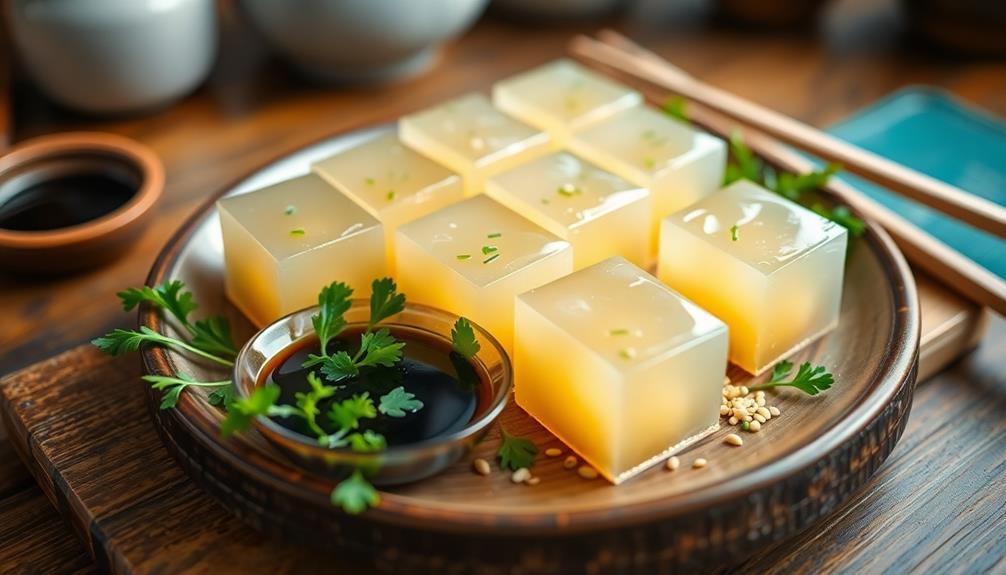Sundubu-jjigae, or Soft Tofu Stew, is a yummy Korean dish that warms your soul! It's made with soft tofu, seafood, and fresh veggies, all simmering in a rich broth and spicy gochugaru. First, you sauté onions and garlic, then add your seafood and veggies. Finally, toss in the tofu and broth, and let it simmer to blend those tasty flavors! Perfect served hot in stone pots, this stew is great with rice and can be customized with more ingredients like beef or mushrooms. It's cozy to share with friends, and there's even more to discover about this delightful dish! If you love the flavorful and comforting experience of Sundubu-jjigae, you might also enjoy exploring the popular Korean army stew recipe, known as Budae-jjigae. This unique dish combines American ingredients like spam, hot dogs, and baked beans with traditional Korean flavors like kimchi and gochujang. It’s a delicious and unexpected fusion that’s perfect for sharing with a group of friends. Exploring the world of Korean stews is a wonderful way to experience the diverse and delicious offerings of Korean cuisine.
Key Takeaways
- Sundubu-jjigae is a Korean soft tofu stew, traditionally originating from Jeolla Province for special occasions and popular among farmers for quick preparation.
- Key ingredients include soft tofu, seafood mix, vegetables, gochugaru, and broth, creating a rich and flavorful dish.
- The stew is typically served hot in stone pots, enhancing the dining experience and allowing for customization with various ingredients.
- Nutritional benefits include high protein from tofu, essential vitamins from vegetables, and immune support from garlic, making it a healthy choice.
- Variations can include different vegetables, meats, and spice levels, allowing for personal preferences and seasonal adaptations.
History
Sundubu-jjigae, a vibrant Korean stew, has its roots deeply embedded in the culinary traditions of Korea. This delicious dish is made with soft tofu, and it's believed to have originated in the Jeolla Province, where families would prepare it for special occasions.
Picture this: a cozy kitchen filled with the warm, spicy smell of kimchi and bubbling stew!
Back in the day, sundubu-jjigae was a favorite among farmers because it's quick to make and packed with flavors. They'd often enjoy it after a long day of work, savoring every spoonful.
The dish has evolved over time, adapting to different tastes and ingredients. You might find variations that include seafood, vegetables, or even meat, adding a unique twist to each bowl.
Today, sundubu-jjigae is loved not just in Korea but all around the world! It's a staple in Korean restaurants, where you can hear the sizzle as it's served hot, right from the pot.
Recipe
Sundubu-jjigae, or soft tofu stew, is a comforting Korean dish that combines silky soft tofu with a spicy and flavorful broth. This dish is known for its rich umami taste and is often enjoyed as a hearty meal, especially during colder months.
It's versatile, allowing for various ingredients such as seafood, vegetables, or meat, making it easy to adapt to personal preferences. The signature element, however, is the soft, uncurdled tofu that melts in your mouth, creating a delightful texture contrast with the broth.
To prepare Sundubu-jjigae, fresh ingredients are key to achieving the best flavors. The stew is typically seasoned with gochugaru (Korean red pepper flakes) for heat and can be topped with a raw egg just before serving for an extra creaminess. Traditionally, it's served bubbling hot in a stone pot, adding to the overall experience.
Whether you're a seasoned cook or a beginner, this dish is sure to impress and can be enjoyed with a bowl of steamed rice.
Ingredients:
- 300g soft tofu
- 150g seafood mix (e.g., shrimp, mussels, or squid)
- 100g zucchini, diced
- 1 small onion, sliced
- 2 green onions, chopped
- 2 tablespoons gochugaru (Korean red pepper flakes)
- 1 tablespoon soy sauce
- 2 cloves garlic, minced
- 1 tablespoon sesame oil
- 1 egg (optional)
- Salt to taste
- 2 cups vegetable or seafood broth
Cooking Instructions:
In a stone pot or a medium saucepan, heat the sesame oil over medium heat. Add the sliced onion and minced garlic, sautéeing until the onion becomes translucent.
Stir in the gochugaru and soy sauce, allowing the spices to bloom for about a minute. Then add the diced zucchini and seafood mix, cooking for a few more minutes.
Pour in the broth, bringing it to a gentle simmer. Carefully add the soft tofu by breaking it into large chunks, and allow everything to simmer for about 5-10 minutes.
If using, gently crack an egg on top just before serving, and garnish with chopped green onions.
Extra Tips:
When making Sundubu-jjigae, feel free to adjust the spice level by varying the amount of gochugaru you use.
You can also experiment with different proteins or add mushrooms for extra flavor. If you want a creamier stew, let the egg cook in the hot broth for a minute before stirring it in.
Serve the stew hot in individual stone pots to keep it warm, and don't forget to pair it with a side of steamed rice to soak up all the delicious broth!
Cooking Steps
Now that you have all your ingredients ready, it's time to jump into the cooking steps for your delicious sundubu-jjigae!
First, you'll sauté the aromatics in oil, filling your kitchen with mouthwatering smells, then carefully add the soft tofu so it stays nice and intact.
Step 1. Prepare Ingredients for Stew
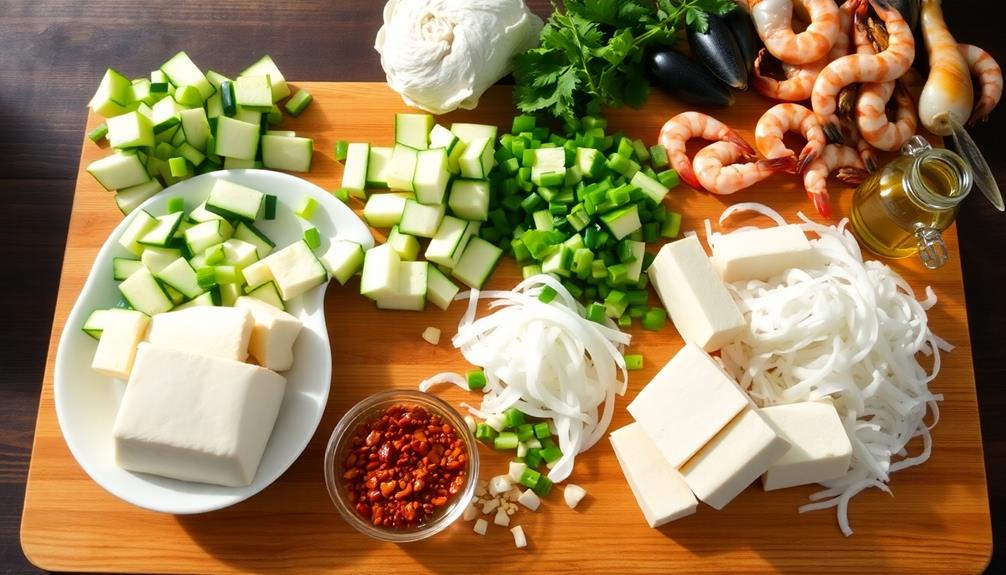
Preparing the ingredients for your stew is crucial for creating a delicious sundubu-jjigae. First, gather your fresh ingredients! You'll need soft tofu, which is the star of the show, along with some vegetables like zucchini, onion, and green onions.
Don't forget a spicy kick from gochugaru, or Korean red pepper flakes, as well as some garlic for flavor.
Next, you'll want to chop everything up! Cut your zucchini into bite-sized pieces, slice the onion thinly, and chop the green onions into small bits. The garlic should be minced as finely as possible, so it blends beautifully into the stew.
Now, if you're using any protein, like seafood or beef, make sure to cut those into small pieces too. This way, they cook evenly and add delicious flavor to your stew!
Lastly, get your broth ready. You can use vegetable or chicken broth, depending on your taste.
With all your ingredients prepped and ready, you're one step closer to making a warming bowl of sundubu-jjigae that'll make everyone smile. Let's get cooking!
Step 2. Sauté Aromatics in Oil
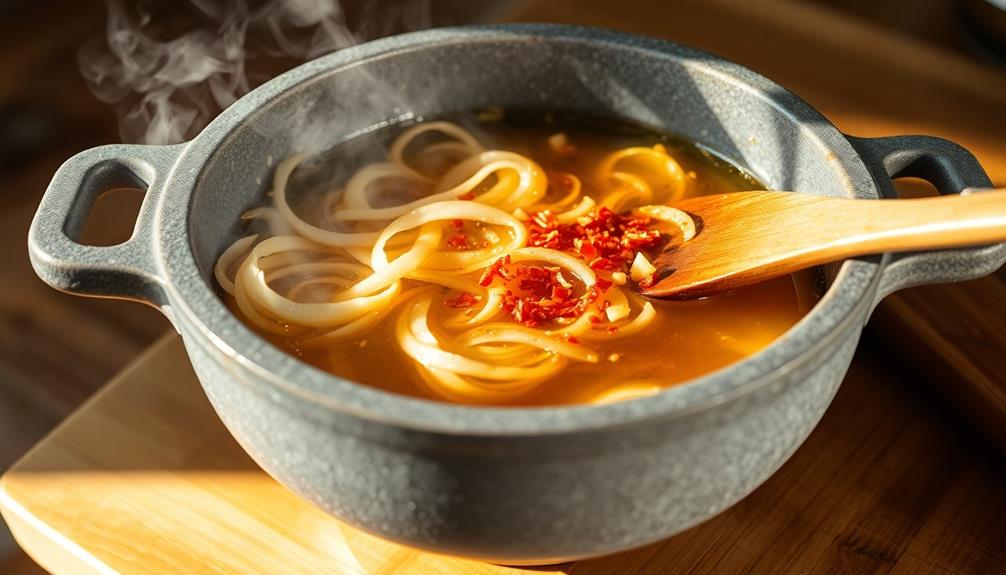
The aroma of sautéed garlic and onions fills the kitchen as you heat a splash of oil in a pot over medium heat.
You'll want to grab those fresh garlic cloves and chop them up, along with a lovely onion. As the oil warms, toss in the chopped onions first, letting them soften and turn a golden color. This will take about two to three minutes, and you can even wiggle your nose and imagine how delicious it'll taste!
Once the onions are translucent, it's time to add in the minced garlic. Be careful not to let it burn, as burnt garlic can taste bitter. Stir it around for about a minute, until it's fragrant and makes your mouth water.
If you want a little kick, this is also the perfect moment to sprinkle in some red pepper flakes! They'll add a pop of flavor and warmth to your dish.
Keep stirring and enjoy the dance of aromas filling your kitchen. You're creating a wonderful base for your Sundubu-jjigae, and you're one step closer to making a delicious meal that'll warm everyone's hearts!
Step 3. Add Soft Tofu Carefully
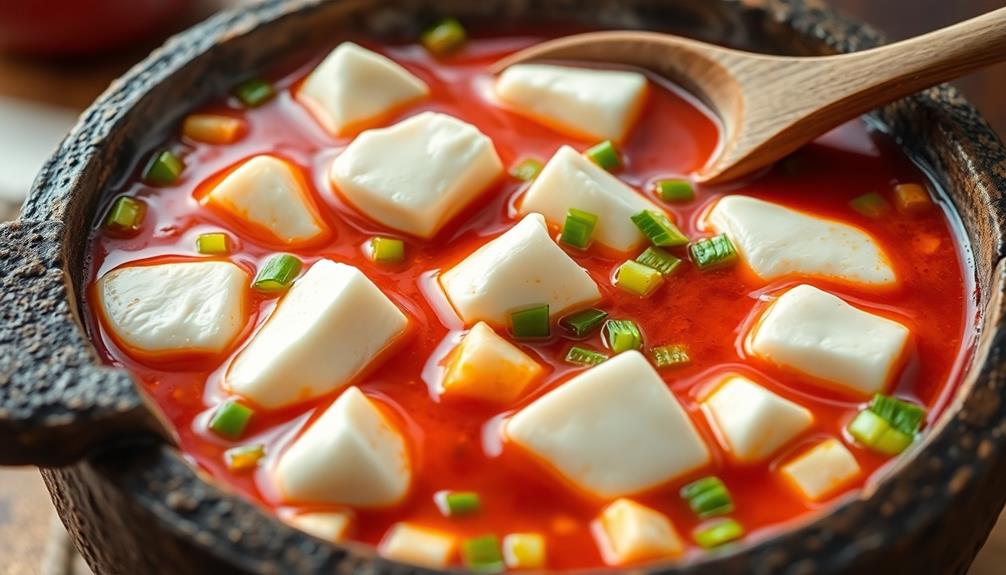
With the aroma of sautéed garlic and onions lingering in the air, it's time to introduce the star ingredient: soft tofu. This isn't just any tofu; it's silky, gentle, and perfect for your sundubu-jjigae!
First, grab a package of soft tofu and gently open it, being careful not to let it break. You want those delicious, soft cubes to stay intact.
Now, using a spoon, scoop out the tofu and add it to your bubbling pot. Don't just dump it in! You'll want to place it in carefully, so it floats on top of your sautéed aromatics. Think of it like placing a delicate cloud onto your delicious stew. As you add the tofu, smile and imagine how cozy it's going to make your dish!
Once you've added all the tofu, it's time to let it shine. You'll want to stir it lightly, mixing it with the flavors below, but don't overdo it! The tofu is like a gentle friend who needs a little space.
With this step complete, you're one step closer to enjoying a warm, wonderful bowl of sundubu-jjigae!
Step 4. Simmer With Broth and Spices
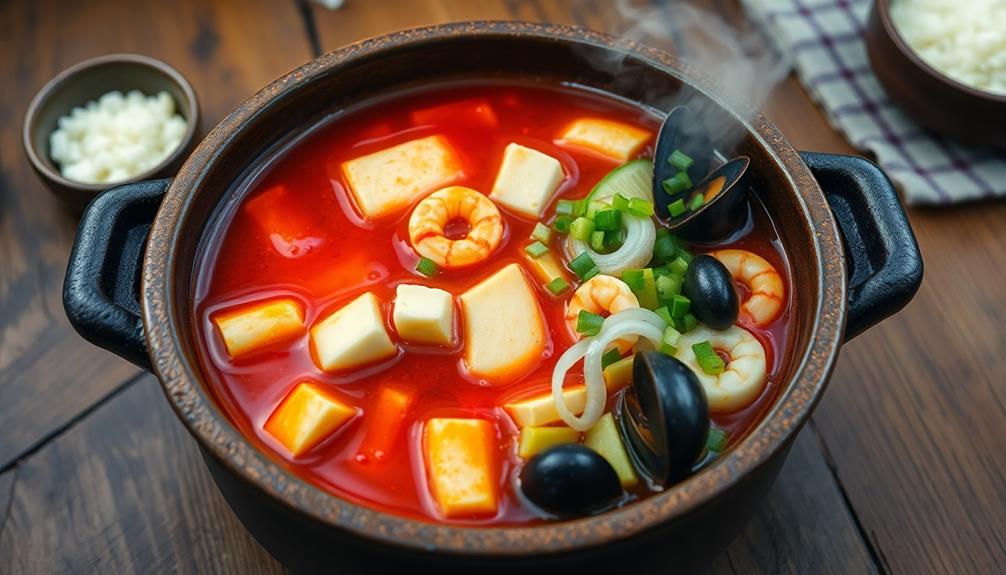
Now that your soft tofu is nestled in the pot, it's time to add a generous amount of broth and spices to bring your sundubu-jjigae to life.
Start by pouring in enough vegetable or chicken broth to cover the tofu. This will create a delicious base for your stew!
Next, grab that gochugaru, or Korean red pepper flakes, and sprinkle in a good amount, depending on how spicy you like it. Don't worry; it won't bite back!
Stir gently to mix everything together, and let the magic happen as all those flavors mingle.
Add a splash of soy sauce for some extra umami, and toss in a dash of sesame oil to give it that nutty aroma.
Now, you want to turn up the heat, bringing the pot to a gentle boil.
Once it's bubbling, reduce the heat to let it simmer. This is where the real fun begins!
As the broth cooks, the spices will infuse into the tofu, making it rich and flavorful.
Keep an eye on it, and let it simmer for about 10–15 minutes, until everything is warm and cozy.
Your sundubu-jjigae is almost ready!
Step 5. Add Vegetables for Flavor

As the broth simmers, it's time to enhance your sundubu-jjigae by adding a medley of vegetables. This is where the fun begins! You can toss in chopped onions, colorful bell peppers, and sliced mushrooms. These veggies not only add a pop of color but also bring amazing flavors to your stew. You'll want to give them a quick stir to make sure they soak up all that delicious broth.
Next, consider adding some leafy greens like spinach or bok choy. They're packed with nutrients and will cook down nicely, adding a lovely texture to your dish. Don't forget about garlic! A few minced garlic cloves can really kick up the flavor.
If you're feeling adventurous, try adding zucchini or even diced carrots for a hint of sweetness. Just remember to chop everything into bite-sized pieces so they cook evenly.
Let those veggies simmer for about five to seven minutes, until they're tender but still a bit crisp. The aroma will be irresistible!
Now, you're ready to introduce the soft tofu to your bubbling creation. Your sundubu-jjigae is shaping up to be a delicious masterpiece!
Final Thoughts
Savoring sundubu-jjigae offers a unique blend of warmth and comfort that resonates deeply with many. When you take a spoonful of this delicious soft tofu stew, you're not just enjoying a meal; you're experiencing a hug in a bowl! The rich flavors, spicy kick, and creamy texture come together to create something truly special.
Whether you're cooking it at home or enjoying it at a restaurant, sundubu-jjigae is perfect for sharing with friends or family. You can customize it with your favorite ingredients, like vegetables, seafood, or even a bit of meat. Each variation brings its own twist, making every bowl a new adventure.
Don't forget to pair it with a side of rice! The fluffy grains soak up the yummy broth, adding even more joy to your dining experience.
Frequently Asked Questions
What Are the Health Benefits of Eating Sundubu-Jjigae?
Eating nutritious dishes boosts your health by providing essential vitamins, minerals, and proteins. You'll benefit from improved digestion, enhanced immunity, and increased energy levels, making it easier to maintain a balanced lifestyle while enjoying delicious meals.
Can Sundubu-Jjigae Be Made Vegan or Vegetarian?
Absolutely! You can easily make it vegan or vegetarian by substituting meat with vegetables or plant-based proteins, using vegetable broth instead of meat broth, and ensuring your seasoning is free from animal products. Enjoy!
What Type of Tofu Is Best for Sundubu-Jjigae?
When making a dish with tofu, you'll want to use soft or silken tofu. They create a creamy texture and absorb flavors well, enhancing your overall experience. Firm tofu won't provide the same results.
How Do I Store Leftover Sundubu-Jjigae?
To store leftovers, let them cool completely before transferring to an airtight container. Refrigerate for up to three days. When you're ready to eat, reheat gently on the stove or in the microwave.
Is Sundubu-Jjigae Spicy, and Can I Adjust the Spice Level?
Yes, it can be spicy! You can easily adjust the spice level by adding less chili paste or using milder ingredients. Just taste as you go, and make it perfect for your palate. Enjoy!




